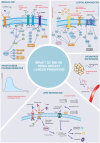Prognostic impact of body mass index (BMI) in HER2+ breast cancer treated with anti-HER2 therapies: from preclinical rationale to clinical implications
- PMID: 35281350
- PMCID: PMC8908398
- DOI: 10.1177/17588359221079123
Prognostic impact of body mass index (BMI) in HER2+ breast cancer treated with anti-HER2 therapies: from preclinical rationale to clinical implications
Abstract
Human Epidermal growth factor Receptor 2 (HER2) overexpression or HER2 gene amplification defines a subset of breast cancers (BCs) characterized by higher biological and clinical aggressiveness. The introduction of anti-HER2 drugs has remarkably improved clinical outcomes in patients with both early-stage and advanced HER2+ BC. However, some HER2+ BC patients still have unfavorable outcomes despite optimal anti-HER2 therapies. Retrospective clinical analyses indicate that overweight and obesity can negatively affect the prognosis of patients with early-stage HER2+ BC. This association could be mediated by the interplay between overweight/obesity, alterations in systemic glucose and lipid metabolism, increased systemic inflammatory status, and the stimulation of proliferation pathways resulting in the stimulation of HER2+ BC cell growth and resistance to anti-HER2 therapies. By contrast, in the context of advanced disease, a few high-quality studies, which were included in a meta-analysis, showed an association between high body mass index (BMI) and better clinical outcomes, possibly reflecting the negative prognostic role of malnourishment and cachexia in this setting. Of note, overweight and obesity are modifiable factors. Therefore, uncovering their prognostic role in patients with early-stage or advanced HER2+ BC could have clinical relevance in terms of defining subsets of patients requiring more or less aggressive pharmacological treatments, as well as of designing clinical trials to investigate the therapeutic impact of lifestyle interventions aimed at modifying body weight and composition. In this review, we summarize and discuss the available preclinical evidence supporting the role of adiposity in modulating HER2+ BC aggressiveness and resistance to therapies, as well as clinical studies reporting on the prognostic role of BMI in patients with early-stage or advanced HER2+ BC.
Keywords: BMI; HER2+ BC; anti-HER2 drugs; clinical outcomes; molecular mechanisms.
© The Author(s), 2022.
Conflict of interest statement
Conflict of interest statement: The authors declared the following potential conflicts of interest with respect to the research, authorship, and/or publication of this article: Filippo de Braud – Consulting Fees: Tiziana Life Sciences, BMS, Celgene, Novartis, Servier, Pharm Research Associates, Daiichi Sankyo, Ignyta, Amgen, Pfizer, Octimet Oncology, Incyte, Pierre Fabre, Eli Lilly, Roche, Astra Zeneca, Gentili, Dephaforum, MSD, Bayer, Fondazione Menarini; Travel/Accommodation/Expenses: BMS, Roche, Celgene, Amgen; Speaker Bureau: BMS, Roche, MSD, Bayer, Ignyta, Dephaforum, Biotechespert Ltd, Prime Oncology, Pfizer; Research Grant/Funding (institution): Novartis, Roche, BMS, Celgene, Incyte, NMS, Merck KGAA, Kymab, Pfizer, Tesaro, MSD. Claudio Vernieri – Consulting Fees: Novartis. All other authors declare no conflict of interest.
Figures

Similar articles
-
Hormone receptor status influences the impact of body mass index and hyperglycemia on the risk of tumor relapse in early-stage HER2-positive breast cancer patients.Ther Adv Med Oncol. 2021 Apr 16;13:17588359211006960. doi: 10.1177/17588359211006960. eCollection 2021. Ther Adv Med Oncol. 2021. PMID: 33948122 Free PMC article.
-
Effect of body mass index on response to neo-adjuvant therapy in HER2-positive breast cancer: an exploratory analysis of the NeoALTTO trial.Breast Cancer Res. 2020 Oct 27;22(1):115. doi: 10.1186/s13058-020-01356-w. Breast Cancer Res. 2020. PMID: 33109233 Free PMC article. Clinical Trial.
-
The association between body mass index and immunohistochemical subtypes in breast cancer.Breast. 2017 Apr;32:227-236. doi: 10.1016/j.breast.2016.09.019. Epub 2016 Oct 15. Breast. 2017. PMID: 27756509
-
Hormone Receptor/Human Epidermal Growth Factor Receptor 2-positive breast cancer: Where we are now and where we are going.Cancer Treat Rev. 2016 May;46:20-6. doi: 10.1016/j.ctrv.2016.03.012. Epub 2016 Apr 1. Cancer Treat Rev. 2016. PMID: 27057657 Review.
-
Targeting HER2 in breast cancer: new drugs and paradigms on the horizon.Explor Target Antitumor Ther. 2021;2(2):139-155. doi: 10.37349/etat.2021.00037. Epub 2021 Apr 30. Explor Target Antitumor Ther. 2021. PMID: 36046143 Free PMC article. Review.
Cited by
-
Pre-treatment [18F]FDG PET/CT biomarkers for the prediction of antibody-drug conjugates efficacy in metastatic breast cancer.Eur J Nucl Med Mol Imaging. 2025 Jan;52(2):708-718. doi: 10.1007/s00259-024-06929-x. Epub 2024 Oct 7. Eur J Nucl Med Mol Imaging. 2025. PMID: 39373900
-
The pan-immune-inflammation value is associated with clinical outcomes in patients with advanced TNBC treated with first-line, platinum-based chemotherapy: an institutional retrospective analysis.Ther Adv Med Oncol. 2023 Apr 13;15:17588359231165978. doi: 10.1177/17588359231165978. eCollection 2023. Ther Adv Med Oncol. 2023. PMID: 37063779 Free PMC article.
-
Predicting HER2 Status Associated with Breast Cancer Aggressiveness Using Four Machine Learning Models.Asian Pac J Cancer Prev. 2024 Oct 1;25(10):3609-3618. doi: 10.31557/APJCP.2024.25.10.3609. Asian Pac J Cancer Prev. 2024. PMID: 39471028 Free PMC article.
-
Impact of body mass index in therapeutic response for HER2 positive breast cancer treated with neoadjuvant targeted therapy: a multi-center study and meta-analysis.NPJ Breast Cancer. 2023 May 31;9(1):46. doi: 10.1038/s41523-023-00552-z. NPJ Breast Cancer. 2023. PMID: 37258524 Free PMC article.
References
Publication types
LinkOut - more resources
Full Text Sources
Research Materials
Miscellaneous

